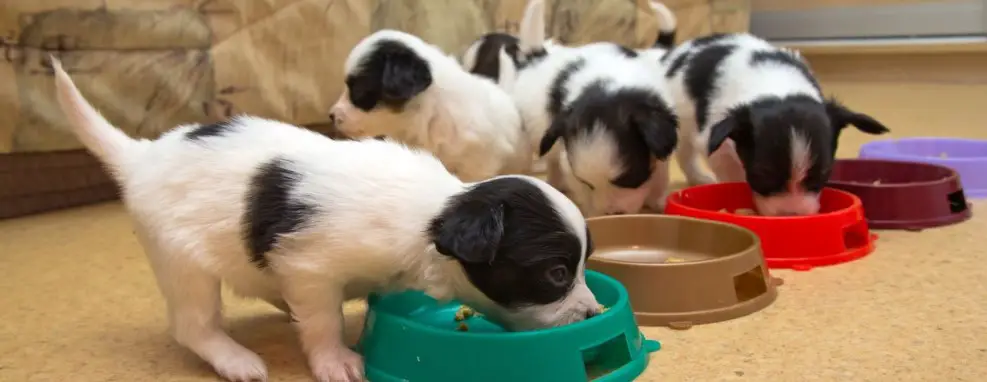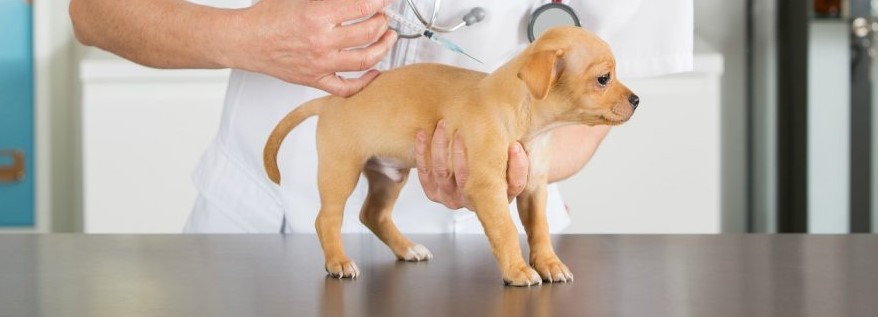Raising Puppies from Birth – Tips, Feeding & Care Guide

The squeals and cries of a newborn puppy is an endearing sound to a potential dog owner.
By the puppy’s very helplessness, a puppy can worm its’ way into your heart before you know it.
But the question is, do you know how to raise a puppy from birth? This guide will help you with that issue.
Preparing the Home for the Puppy
There are some guidelines to prepare your home before you bring home your puppy.
A puppy will chew on and swallow about anything he can sink his baby teeth into. You will need to pick up any debris on the floor, which may be dangerous. You will need to secure and elevate any electrical cords.
To puppy-proof rooms which you don’t want your puppy to enter, use baby gates. These gates need to be secured tightly and opened quickly. Plus, you should be able to see your puppy through it know what he’s up to.
For equipment, you’ll need a travel crate, a dog bed, food and water bowls, piddle pads and newspapers, dog collar, leash, and a crate, if you plan on crating him.
The collar and leash are for exercise, and toys are to make him feel comfortable. Be sure to buy only safe toys for him to chew and snuggle to keep your puppy content and happy.
What Puppies Eat

A puppy will nurse about every two weeks until they’re about a week old. As the puppy grows, the length of time between feedings lengthen.
When your puppy turns four weeks old, he can start to transition from nursing to start eating dry food.
A puppy should be on dry food at about 7-8 weeks old, and the need for a milk replacer isn’t necessary any longer. Ask your vet about what the best type of high-quality food they recommend.
The nutrient needs of a puppy change rapidly in the first six months, so a high-quality diet is needed.
Your puppy is growing rapidly and needs a lot of calories, so he’ll be eating three times a day until he is four to six months old. Your puppy will grow the fastest in the first five months of his life.
Usually there is a a feeding chart on the puppy food you’re feeding, and you can use it as a guide for the right amount of food.
When your puppy has been on his food for about six months, give him a once over. He should have a thick, shiny coat and be playful and energetic.
Your puppy’s feces should be formed and brown, which means he’s digesting almost all the nutrients in his food.
If you’re feeding your puppy correctly, you shouldn’t feel any fat on his ribs. The top of his backbone will show, and his ribs will be visible. Your puppy should have an abdominal tuck when looking at him from the side, and you should see a waist.
When giving your puppy treats, aim for no more than 5% of daily calories, and be sure the treats are the right size for your puppy.
You can give him healthy treats like green beans, bell peppers, and small bites of carrots. Avoid table scraps that may cause stomach issues, pancreatitis, or a serious illness.
Newborn Puppy Health Problems

There are health issues that can happen to newborn puppies. A healthy puppy shouldn’t have a cleft palate but have a healthy sucking reflex.
The anus and urethra should be normal and functioning. Your puppy should have moist mucous membranes, pink gums, and a healthy coat.
Your puppy should be weighted with a baby scale at birth. Then he should be weighed at 12 hours, 24 hours, 48 hours, 3 days, 5 days, and 7 days. During this weigh-in time, he should show a gradual weight gain.
One of the biggest health concerns for your newborn puppy is regulation of temperature. A low body temperature puts stress on his weak immunity system, impacts his ability to not only nurse but to digest food.
If your puppy does become chilled, warm him back up gradually and stop feeding him until he’s warm again.
You should call a vet if your puppy has any of the following symptoms:
- lack of appetite or poor weight gain
- diarrhea and vomiting
- coughing/wheezing, difficulty breathing
- pale gums, swollen eye or eye discharge
- constant crying, nasal discharge inability to pass urine or stool
Key Stages of Puppy Growth

Understanding the key stages of a puppy’s growth is essential. Your puppy will change in his size, behavior, and shape during the first year of his life.
Depending on what type of puppy you have, growth will happen at different paces and there signs to look for.
The first two weeks of your puppy’s life are essential to make sure the transition into adulthood is a healthy one.
Check on him within the first 48 hours of his life to make sure he’s getting the nutrition he needs. Between the days of nine and thirteen, your puppy will double in weight; if he isn’t, you may want to call the vet.
Your pup will start to have baby teeth appear within the first month, but the tooth and jaw strength is still weak.
His weight will multiply by four within the next 25 to 30 days, and the baby hair will be replaced by real fur. Your puppy isn’t in his growth spurt stage, but starting your pup’s appropriate weaning food can begin now.
When your puppy has stopped feeding on his mother’s milk between four to twelve weeks, then he will be in an immunity gap. Your puppy can be susceptible to illness at this point because his body hasn’t developed his own immune system. Watch him very closely for signs of any illness.
At three to five months, your pup will be growing rapidly no matter what size breed he is. A large breed dog at five months will have developed the skeletal structure he will need for adulthood, and he’ll be half his adult weight.
If your pup is going to grow into a small dog, he’ll be going through his most active growth cycle so you can start to give him a larger kibble.
When your puppy is eight to ten months old, if you have a small breed dog, he will have reached his adult size and weight.
But, if your pup is a large breed, he will continue to grow, and within the eight to nine-month span, the growth is within his organs and skeleton.
A large breed dog will grow to 100 times his birth weight while a small breed dog will grow 20 times his birth weight.
At eighteen to twenty-four months in a large breed dog, he will be fully mature. At this time, he will put on the muscle of an adult dog while phasing out the growth cycle.
Your puppy will get heavier and bulk out and will look more like an adult dog.
Why Your Puppy Needs A Vet Visit

Your puppy needs to have his first vet visit at about six weeks of age. This will start him on his first round of vaccinations with deworming and a physical examination.
Knowing that your puppy has a clean bill of health will start him on his life journey without issue.
But if you don’t take your puppy to the vet, below are six common illnesses he could catch before he’s a year old:
- Distemper: Your puppy’s first vaccine will be given between six to eight weeks and then again at nine weeks, which he then is immune. Distemper starts as an upper respiratory infection with eye discharge and sneezing. Pneumonia can develop, or it can lead to neurological problems, which can be fatal.
- Parvovirus or Parvo: Your puppy can be attacked with this disease between twelve weeks to three years. It’s passed on from one dog to the next through bodily secretions and other dogs that haven’t been vaccinated. It starts with a fever, then vomiting, and bloody diarrhea, which causes weakness and dehydration. If diagnosed with this, your pup will be hospitalized three to four days, placed on IV fluids, and given antibiotics.
- Kennel cough: Your pup doesn’t have to be in a kennel to contract kennel cough because it’s a bacterial infection that is airborne. The cough begins with decreased appetite, lethargy, fever, and if not treated a deep, productive cough. If not treated, it can lead to pneumonia, so shots for puppies can start between six to twelve months.
- Leptospirosis: Your puppy’s kidneys and liver can be affected by this disease, which is transmitted through contaminated urine and water. The symptoms are fever/vomiting/and/or lethargy, but the symptoms are vague and flu-like. The treatment is antibiotics, but your puppy can be vaccinated for it between ten to twelve weeks.
- Vomiting and diarrhea: One thing to do is to rule out internal parasites, but if no parasites are present, then there may be another issue. Sometimes your puppy may have eaten or licked something he shouldn’t have and vomiting, and diarrhea is the result. If he has been throwing up for over 12 hours or has had diarrhea for over 24, your pup needs to go to the vet immediately.
If You’re Raising a Motherless Newborn Puppy
Sometimes you end up raising a motherless newborn puppy whose mother rejected the puppy or can’t nurse him.
The first thing is to make sure the puppy is kept warm in a draft-free environment. Puppies can’t control the temperature of their bodies; a cold puppy becomes stressed and will expose him to disease.
You can place a heat lamp where the puppy’s bed is but make sure it is high enough not to burn him. If your puppy becomes too warm, he can crawl to a corner of the bed where its cooler. A heating lamp is more highly recommended than a heating pad since a heating pad is more prone to burn a puppy.
What to Feed Newborn Puppies Without a Mother

The best replacement milk for a puppy without a mother is a commercial puppy milk formula. These formula bags come with mixing guidelines and how much to feed a puppy.
You may think it’s easier to mix up a large batch of formula but don’t because bacteria could breed and sicken your puppy.
The formula needs to be warmed to about 100 degrees, and the bottle angled to prevent air bubbles when feeding.
If the hole is too small in the nipple, it can be made more prominent when pierced with a hot needle. You need to feed your puppy facedown because if you feed him on his back or upright, he could choke.
Your puppy may also need help eliminating and will need to be stimulated in the genital area. You can do this by dipping a clean cotton ball in warm water and rubbing the genital and anal area.
Also, grooming your puppy is vital for health and development, so stroke your puppy’s back and sides a couple of times a day with a soft cloth.
Sometimes a newborn puppy doesn’t know how to suckle, or he has a cleft palate. If he doesn’t get the hang of it, then you may have to ask a vet how to tube feed or syringe feed your pup.
The Question Why Some Female Dogs Kill Their Puppies
Many people wonder why some female dogs kill their puppies.
Puppies with bite marks or missing their heads or have other significant injuries, which is a cause of death can be upsetting when the puppies are found. But there are several reasons why a female dog will kill their young.
Some of the reasons are the puppies being killed accidentally is by the mother lying down on the puppies, smothering, or crushing them.
Or, a puppy could be sick or have something wrong with them, and natural selection is instinct. Too, a mother dog could be inexperienced or be an unstable female and should have never been bred.
If the mother is stressed by not having enough privacy or a quiet place, she could kill her puppies. Sometimes too many visitors are interrupting her, or the litter itself could be too big. Or, the mother just not may recognize the puppies as hers.
Another issue is nursing itself, which could be painful from a condition called mastitis, which would make her reject her young.
As you can see, raising a puppy from birth can be time-consuming but also rewarding. If you find yourself in a situation taking care of a newborn puppy, now you have a guide that will help you.
Below is a video of how to feed a motherless puppy if you have any questions on how to do it correctly.
https://www.youtube.com/watch?v=JrvxGIDMGUM


